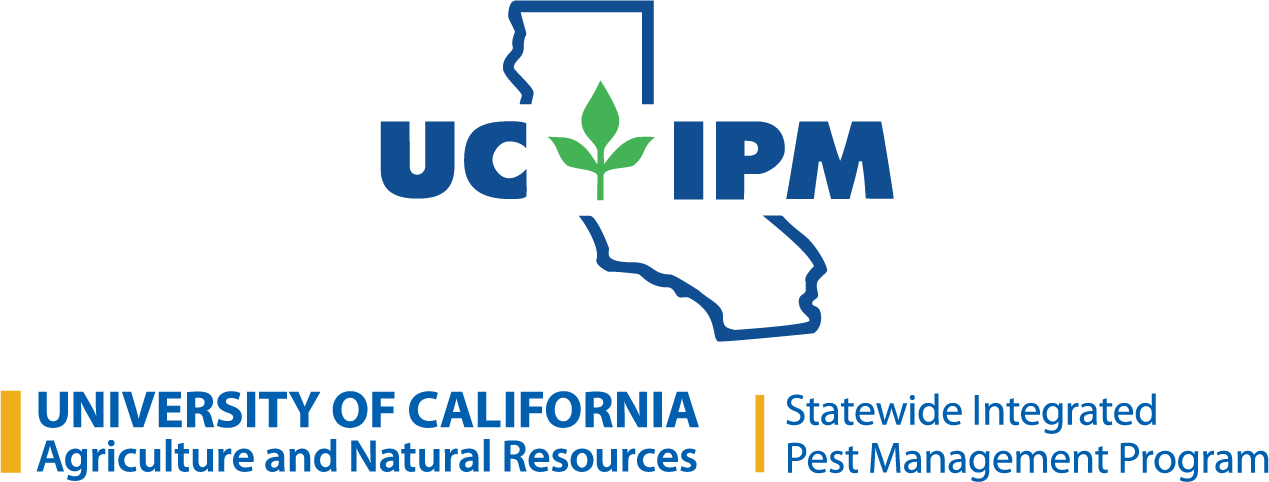Quick Tips
Integrated pest management (IPM) uses environmentally sound, yet effective, ways to keep pests from annoying you or damaging plants. IPM programs usually combine several pest control methods for long-term prevention and management of pest problems without harming you, your family, or the environment. Successful IPM begins with correct identification of the pest. Only then can you select the appropriate IPM methods and materials.
Preferred IPM methods include:
- Planting pest-resistant or well-adapted plant varieties such as native plants.
- Discouraging pests by modifying the way you design, irrigate, fertilize, and manage your garden.
- Altering the garden or home environment to deprive pests of the food, water, shelter, or other requirements they need to thrive.
- Keeping pests out of the home and garden using barriers, screens, and caulking.
- Squashing, trapping, washing off, or pruning out pests.
- Relying on good bugs in your garden to eat pests, eliminating the need for insecticides that can end up in our waterways.
Turning to pesticides:
- Many pests can be managed without the use of pesticides.
- Use pesticides only if nonchemical controls are ineffective and pests are reaching intolerable levels.
- Use pesticides in combination with the methods described above.
- Choose pesticides carefully. Use the least toxic, most effective material to protect human health and the environment.
- Examples of least toxic insecticides include:
- Soaps;
- Oils; and
- Microbials such as Bacillus thuringiensis (Bt) and spinosad.
Most gardens contain far more good bugs, or beneficial insects, than pest insects. Beneficial insects and other organisms that kill pests are called natural enemies. In any pest management program, it is important to encourage these natural enemies by avoiding pesticides that kill them. You also can encourage beneficial insects by choosing plants that provide them with pollen, nectar, and shelter and keeping ants out of pest-infested plants. Learn to identify good bugs, both in their adult forms and immature (larval) stages.
Common good bugs found in California gardens include:
- Lady beetles: Adults and larvae eat aphids.
- Lacewings: Larvae feed on many insect pests; you’ll often see adults around lights.
- Syrphid flies: Larvae eat aphids, and adults hover around flowers.
- Parasitic mini-wasps: Many species of tiny wasps lay their eggs in pests such as aphids or caterpillars; their hatching larvae consume the pest and kill it.
- Spiders: All spiders feed on insects or other arthropods and are beneficial in the garden.
Download a PDF of this Quick Tips. Descargue un PDF de estos Notas Breves.
Pest Notes: Introduction
Biological control is the beneficial action of parasites, pathogens, and predators in managing pests and their damage. Biocontrol provided by these living organisms, collectively called “natural enemies,” is especially important for reducing the numbers of pest insects and mites. Use of natural enemies for biological control of rangeland and wildland weeds (e.g., Klamath weed, St. Johnswort) is also effective. Plant pathogens, nematodes, and vertebrates also have many natural enemies, but this biological control is often harder to recognize, less well understood, and/or more difficult to manage. Conservation, augmentation, and classical biological control are tactics for harnessing natural enemies’ benefits.

Types of Natural Enemies
Parasites, pathogens, and predators are the primary groups used in biological control of insects and mites (Table 1). Most parasites and pathogens, and many predators, are highly specialized and attack a limited number of closely related pest species. Learn how to recognize natural enemies by consulting resources such as the Natural Enemies Handbook and the Natural Enemies Gallery.
Table 1. Some Pests and Their Common Natural Enemies.
|
NATURAL ENEMIES | |||||
|---|---|---|---|---|---|---|
| PESTS | Lacewings | Lady beetles | Parasitic flies | Parasitic wasps | Predatory mites | Other Groups and Examples |
aphids |
X |
X |
|
X |
|
entomopathogenic fungi, soldier beetles, syrphid fly larvae |
carpenterworm, clearwing moth larvae |
|
|
|
X |
|
entomopathogenic nematodes |
caterpillars (e.g., California oakworm) |
X |
|
X |
X |
|
Bacillus thuringiensis, birds, entomopathogenic fungi and viruses, predaceous bugs and wasps, Trichogramma spp. (egg parasitic wasps), spiders |
cottony cushion scale |
|
X |
X |
|
|
Cryptochaetum iceryae (parasitic fly), vedalia beetle |
elm leaf beetle |
|
|
X |
X |
|
Erynniopsis antennata (parasitic fly), Oomyzus (=Tetrastichus) spp. (parasitic wasps) |
eucalyptus longhorned borers |
|
|
|
X |
|
Avetianella longoi (egg parasitic wasp) |
eucalyptus redgum lerp psyllid |
|
|
|
X |
|
Psyllaephagus bliteus (parasitic wasp) |
giant whitefly |
X |
X |
|
X |
|
Encarsia hispida, Encarsia noyesi, Entedononecremnus krauteri, and Idioporus affinis (parasitic wasp), syrphid fly larvae |
glassy-winged sharpshooter |
X |
|
|
X |
|
assassin bugs, Gonatocerus spp. (egg parasitic wasps), spiders |
lace bugs |
X |
X |
|
X |
|
assassin bugs and pirate bugs, spiders |
mealybugs |
X |
X |
|
X |
|
mealybug destroyer lady beetle |
mosquitoes |
|
|
|
|
|
Bacillus thuringiensis spp. israelensis, mosquito-eating fish |
psyllids |
X |
X |
|
X |
|
pirate bugs |
scales |
X |
X |
|
X |
X |
Aphytis, Coccophagus, Encarsia, and Metaphycus spp. parasitic wasps |
slugs, snails |
|
|
X |
|
|
Rumina decollata (predatory snail), predaceous ground beetles, birds, snakes, toads, and other vertebrates |
spider mites |
X |
X |
|
|
X |
bigeyed bugs and minute pirate bugs, Feltiella spp. (predatory cecidomyiid fly larvae), sixspotted thrips, Stethorus picipes (spider mite destroyer lady beetle) |
thrips |
X |
|
|
X |
X |
minute pirate bugs, predatory thrips |
weevils, root or soil-dwelling |
|
|
|
X |
|
Steinernema carpocapsae and Heterorhabditis bacteriophora (entomopathogenic nematodes) |
whiteflies |
X |
X |
|
X |
|
bigeyed bugs and minute pirate bugs, Cales |
Parasites
A parasite is an organism that lives and feeds in or on a host. Insect parasites can develop on the inside or outside of the host’s body. Often only the immature stage of the parasite feeds on the host. However, adult females of certain parasites (such as many wasps that attack scales and whiteflies) feed on and kill their hosts, providing an easily overlooked but important source of biological control in addition to the host mortality caused by parasitism.
Although the term “parasite” is used here, true parasites (e.g., fleas and ticks) do not typically kill their hosts. Species useful in biological control, and discussed here, kill their hosts; they are more precisely called “parasitoids.”
Most parasitic insects are either flies (Order Diptera) or wasps (Order Hymenoptera). Parasitic wasps occur in over three dozen Hymenoptera families. For example, Aphidiinae (a subfamily of Braconidae) attack aphids. Trichogrammatidae parasitize insect eggs. Aphelinidae, Encyrtidae, Eulophidae, and Ichneumonidae are other groups that parasitize insect pests. It’s important to note that these tiny to medium-sized wasps are incapable of stinging people. The most common parasitic flies are the typically hairy Tachinidae. Adult tachinids often resemble house flies. Their larvae are maggots that feed inside the host.

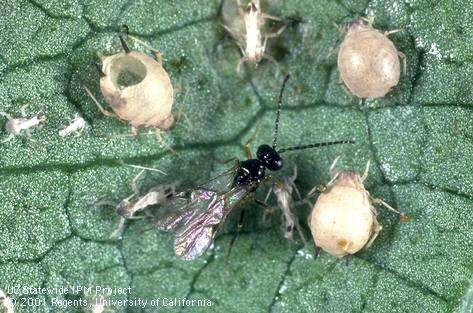
Some Important Parasites of Insects.
- Anaphes species
- Aphidius species
- Aphytis spp., armored scale parasites
- Bracon cushmani, grape leaffolder parasite
- Citrus mealybug parasite
- Cotesia medicaginis, alfalfa butterfly parasite
- Cottony cushion scale parasite
- Elm leaf beetle parasite
- Encarsia formosa, whitefly parasite
- Hyposoter exiguae, caterpillar parasite
- Lysiphlebus testaceipes, aphid parasite
- Tachinid flies
- Trichogramma spp., egg parasites
- Trioxys pallidus, walnut aphid parasite
Pathogens
Natural enemy pathogens are microorganisms including certain bacteria, fungi, nematodes, protozoa, and viruses that can infect and kill the host. Populations of some aphids, caterpillars, mites, and other invertebrates are sometimes drastically reduced by naturally occurring pathogens, usually under conditions such as prolonged high humidity or dense pest populations. In addition to a naturally occurring disease outbreak (epizootic), some beneficial pathogens are commercially available as biological or microbial pesticides. These include Bacillus thuringiensis or Bt, entomopathogenic nematodes, and granulosis viruses. Additionally, some microorganism by-products, such as avermectins and spinosyns are used in certain insecticides; but applying these products is not considered to be biological control.
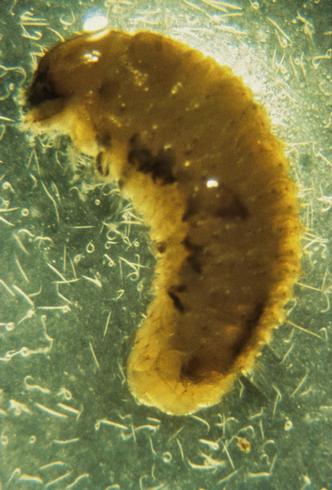
Predators
Predators kill and feed on several to many individual prey during their lifetimes. Many species of amphibians, birds, mammals, and reptiles prey extensively on insects. Predatory beetles, flies, lacewings, true bugs (Order Hemiptera), and wasps feed on various pest insects or mites. Most spiders feed entirely on insects. Predatory mites that feed primarily on pest spider mites include Amblyseius spp., Neoseiulus spp., and the western predatory mite, Galendromus occidentalis.
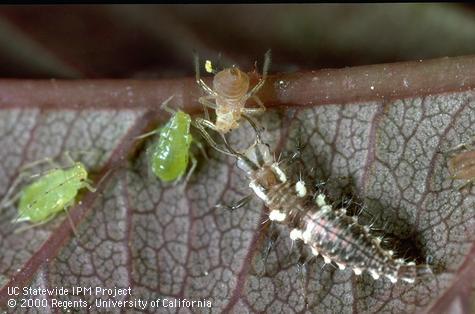
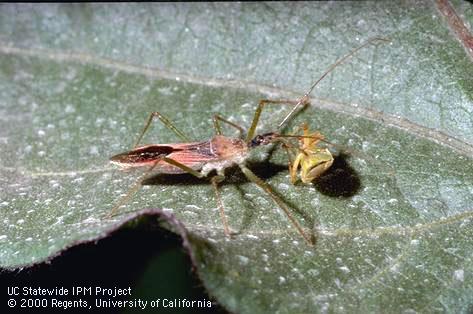
Some Important Insect and Mite Predators.
- Assassin bugs
- Bigeyed bugs
- Brown lacewings
- Convergent lady beetle
- Damsel bugs
- Decollate snail
- Dustywings
- Euseius tularensis
- Green lacewings
- Mealybug destroyer
- Minute pirate bugs
- Multicolored Asian lady beetle
- Phytoseiulus persimilis
- Predaceous ground beetles
- Predaceous midge, aphid midge
- Sevenspotted lady beetle
- Sixspotted thrips
- Soldier beetles, leather-winged beetles
- Spider mite destroyer lady beetle
- Spiders
- Syrphid flies
- Twicestabbed lady beetle
- Vedalia beetle
- Western predatory mite
Recognizing Natural Enemies
Proper identification of pests, and distinguishing pests from natural enemies, is essential for effective biological control. Carefully observe the mites and insects on your plants to help discern their activity. For example, some people may mistake syrphid fly larvae for caterpillars. However, syrphid fly larvae are found feeding on aphids and not chewing on the plant itself. If you find mites on your plants, observe them with a good hand lens. Predaceous mites appear more active than plant-feeding species. In comparison with pest mites, predaceous mites are often larger and do not occur in large groups.
Consult publications listed in the References to learn more about the specific pests and their natural enemies in your gardens and landscapes. Take unfamiliar organisms you find to your local University of California (UC) Cooperative Extension office, UC Master Gardener Program, or agricultural commissioner office in your county for aid in identification.
Conservation: Protect Natural Enemies
Preserve existing natural enemies by choosing cultural, mechanical, or selective chemical controls that do not harm beneficial species. Remember, only about 1% of all insects and mites are harmful. Most pests are attacked by multiple species of natural enemies (Table 1), and their conservation is the primary way to successfully use biological control. Judicious (e.g., selective, timing) pesticide use, ant control, and habitat manipulation are key conservation strategies.
Pesticide Management
Biological control’s importance often becomes apparent when broad-spectrum, residual pesticides (those that persist for days or weeks) cause secondary pest outbreaks or pest resurgence. An example is the dramatic increase in spider mite populations (flaring) that sometimes results after applying a carbamate (e.g., carbaryl* or Sevin) or organophosphate (malathion) to control caterpillars or other insects.
Eliminate or reduce the use of broad-spectrum, persistent pesticides whenever possible. Carbamates, organophosphates, and pyrethroids kill natural enemies that are present at the time of spraying and for days or weeks afterwards their residues kill predators and parasites that migrate in after spraying. Neonicotinoids (e.g., dinetofuran, imidacloprid) and other systemic insecticides that translocate (move) into blossoms can poison natural enemies and honey bees that feed on nectar and pollen. Even if beneficials survive an application, low levels of pesticide residues can interfere with natural enemies’ reproduction and their ability to locate and kill pests.
When pesticides are used, apply them in a selective manner. Treat only heavily infested areas with “spot” applications instead of entire plants. Choose insecticides that are more specific in the types of invertebrates they kill, such as Bacillus thuringiensis (Bt) that kills only caterpillars that consume treated foliage.
For most other types of exposed-feeding insects, rely on contact insecticides with little or no persistence, including azadirachtin, insecticidal soap, narrow-range oil (horticultural oil), neem oil, and pyrethrins, which are often combined with the synergist piperonyl butoxide.
In situations where you wish to foster biological control, use of nonpersistent pesticides can provide better long-term control of the pest because they do less harm to natural enemies that migrate in after the application. To obtain adequate control, thoroughly wet the infested plant parts with spray beginning in spring when pests become abundant. To provide sustained control, repeated application may be needed.
For certain harder-to-control pests where contact-only insecticides are inadequate, other choices include spinosad, a fermentation product of a naturally occurring bacterium. This insecticide persists about 1 week and it has translaminar activity (is absorbed short distances into plant tissue). Spinosad can be toxic to certain natural enemies (e.g., predatory mites, Trichogramma wasps, and syrphid fly larvae) and bees when sprayed and for about 1-4 days afterwards; do not apply spinosad to plants that are flowering.
| TOXICITY TO PARASITES AND PREDATORS1 | ||
|---|---|---|
| INSECTICIDE | Direct | Residual |
microbial (Bacillus thuringiensis) |
no | no |
botanicals (pyrethrins) |
yes/no2 | no |
oil (horticultural), soap (potash soap) |
yes | no |
microbial (spinosad) |
yes/no2 | yes/no2 |
neonicotinoids (imidacloprid) |
yes/no2 | yes |
carbamates (carbaryl*), organophosphates (malathion), pyrethroids (bifenthrin) |
yes | yes |
1. Direct contact toxicity is killing within several hours from spraying the beneficial or its habitat. Residual toxicity is killing or sublethal effects (such as reduced reproduction or ability to locate and kill pests) due to residues that persist. 2. Toxicity depends on the specific material and how it is applied and the species and life stage of the natural enemy. See the active ingredients database for more information about specific pesticides. |
Ant Control and Honeydew Producers
The Argentine ant and certain other ant species are considered pests primarily because they feed on honeydew produced by insects that suck phloem sap, such as aphids, mealybugs, soft scales, psyllids, and whiteflies. Ants protect honeydew producers from predators and parasites that might otherwise control them. Ants sometimes move these honeydew-producing insects from plant to plant (called “farming”). Where natural enemies are present, if ants are controlled, populations of many pests will gradually (over several generations of pests) be reduced as natural enemies become more abundant. Control methods include cultivating soil around ant nests, encircling trunks with ant barriers of sticky material, and applying insecticide baits near plants. See Pest Notes: Ants for more information.
Habitat Manipulation
Plant a variety of species that flower at different times to provide natural enemies with nectar, pollen, and shelter throughout the growing season. The adult stage of many insects with predaceous larvae (such as green lacewings and syrphid flies) and many adult parasites feed only on pollen and nectar. Even if pests are abundant for the predaceous and parasitic stages, many beneficials will do poorly unless flowering and nectar-producing plants are available to supplement their diet. To retain predators and parasites, grow diverse plant species well adapted to the local conditions and that tolerate low populations of plant-feeding insects and mites so that some food is always available.
Other cultural controls that can help natural enemies include reducing dust and properly fertilizing and irrigating. Dust can interfere with natural enemies and may cause outbreaks of pests such as spider mites. Reduce dust by planting ground covers and windbreaks and hosing off small plants that become excessively covered with dust. Avoid excess fertilization and irrigation, which can cause phloem-feeding pests, such as aphids, to reproduce more rapidly than natural enemies can provide control.
Augmentation
When resident natural enemies are insufficient, their populations can sometimes be increased (augmented) through the purchase and release of commercially available beneficial species. However, there has been relatively little research on releasing natural enemies in gardens and landscapes. Releases are unlikely to provide satisfactory pest control in most situations. Some marketed natural enemies are not effective. Many natural enemies are generalist predators and are cannibalistic and feed indiscriminately on pest and beneficial species, thereby reducing their effectiveness.
Only a few natural enemies can be effectively augmented in gardens and landscapes. For example, entomopathogenic nematodes can be applied to control certain tree-boring and lawn-feeding insects. Convergent lady beetles (Hippodamia convergens) purchased in bulk through mail order, stored in a refrigerator, and released in very large numbers at intervals can temporarily control aphids; however, lady beetles purchased through retail outlets are unlikely to be sufficient in numbers and quality to provide control.
Successful augmentation generally requires advanced planning, biological expertise, careful monitoring, optimal release timing, patience, and situations where certain levels of pests and damage can be tolerated. Situations where pests or damage are already abundant are not good opportunities for augmentation.
Classical Biological Control or Importation
Classical biological control, also called importation, is primarily used against exotic pests that have inadvertently been introduced from elsewhere. Many organisms that are not pests in their native habitat become unusually abundant after colonizing new locations without their natural controls. Researchers go to the pest’s native habitat, study and collect the natural enemies that kill the pest there, then ship promising natural enemies back for testing and possible release. Many insects and some weeds that were widespread pests in California are now partially or completely controlled by introduced natural enemies, except where these natural enemies are disrupted, such as by pesticide applications or honeydew-seeking ants.
By law, natural enemy importation must be done only by qualified scientists with government permits. Natural enemies are held and studied in an approved quarantine facility to prevent their escape until research confirms that the natural enemy will have minimal negative impact in the new country of release.
It is important for landscape managers to recognize imported natural enemies and conserve them whenever possible. Because classical biological control can provide long-term benefits over a large area and is conducted by agencies and institutions funded through taxes, public support is critical to the continued success of classical biological control.
Is Biological Control “Safe”?
A great benefit of biological control is its relative safety for human health and the environment, compared to widespread use of broad-spectrum pesticides. Most negative impacts from exotic species have been caused by undesirable organisms contaminating imported goods, by travelers carrying in pest-infested fruit, and from introduced ornamentals that escape cultivation and become weeds. These ill-advised or illegal importations are not part of biological control.
Negative impacts have occurred from poorly conceived, quasi-biological control importations of predaceous vertebrates like frogs, mongooses, and certain fish, often conducted by nonscientists. To avoid these problems, biological control researchers follow government quarantine regulations and work mostly with host-specific natural enemies that pose low risks and can provide great benefits. As a pest comes under biological control, population densities decline for both the pest and the biological control agent because host-specific natural enemies cannot prey or reproduce on other species.
*As of August 1, 2020, pesticides containing the active ingredient carbaryl are restricted use materials in California. A valid pesticide applicator’s license is required for their possession and use. For more information see the California Department of Pesticide Regulation website.
References
Dreistadt SH. 2016. Pests of Landscape Trees and Shrubs, 3rd Edition. UC ANR Publication 3359, Oakland, CA.
Flint, M.L. and S.H. Dreistadt. 1998. Natural Enemies Handbook: The Illustrated Guide to Biological Pest Control. Oakland: Univ. Calif. Div. Agric. Nat. Res. Publ. 3386.
Rust, M.K. and D.-H. Choe. 2012. Pest Notes: Ants. Oakland: Univ. Calif. Agric. Nat. Res. Publ. 7411.
Important Links
- Quick Tips Beneficial Predators
- Quick Tips Common Garden Spiders
- Quick Tips Lady Beetles
- Quick Tips Parasites of Insect Pests
- Natural Enemies Gallery
- More biological control resources
Resources
- About Pest Notes
- Glossary
- Compare Risks from Pesticides Mentioned
- WARNING ON THE USE OF PESTICIDES
- List of other Pest Notes


